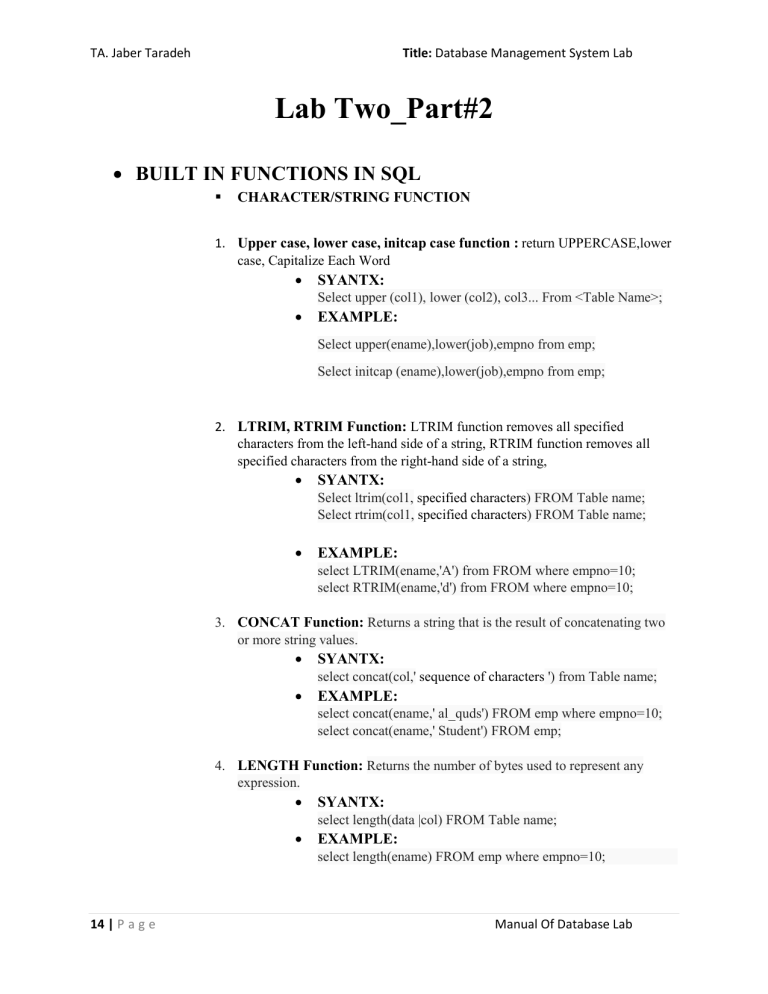SQL Functions & Queries Lab Manual
advertisement

TA. Jaber Taradeh
Title: Database Management System Lab
Lab Two_Part#2
BUILT IN FUNCTIONS IN SQL
CHARACTER/STRING FUNCTION
1. Upper case, lower case, initcap case function : return UPPERCASE,lower
case, Capitalize Each Word
SYANTX:
Select upper (col1), lower (col2), col3... From <Table Name>;
EXAMPLE:
Select upper(ename),lower(job),empno from emp;
Select initcap (ename),lower(job),empno from emp;
2. LTRIM, RTRIM Function: LTRIM function removes all specified
characters from the left-hand side of a string, RTRIM function removes all
specified characters from the right-hand side of a string,
SYANTX:
Select ltrim(col1, specified characters) FROM Table name;
Select rtrim(col1, specified characters) FROM Table name;
EXAMPLE:
select LTRIM(ename,'A') from FROM where empno=10;
select RTRIM(ename,'d') from FROM where empno=10;
3. CONCAT Function: Returns a string that is the result of concatenating two
or more string values.
SYANTX:
select concat(col,' sequence of characters ') from Table name;
EXAMPLE:
select concat(ename,' al_quds') FROM emp where empno=10;
select concat(ename,' Student') FROM emp;
4. LENGTH Function: Returns the number of bytes used to represent any
expression.
SYANTX:
select length(data |col) FROM Table name;
EXAMPLE:
select length(ename) FROM emp where empno=10;
14 | P a g e
Manual Of Database Lab
TA. Jaber Taradeh
Title: Database Management System Lab
5. REPLACE Function: Replaces all occurrences of a specified string value
with another string value.
SYANTX:
Select replace (string_expression, string pattern,
string_replacement) FROM Table name;
EXAMPLE:
Select replace (ename, 'Ah','moham') from emp where empno=
10;
6. SUBSTRING Function: Returns part of a character, binary, text, or image
expression in SQL Server.
SYANTX:
Select substr( expression, start, length) FROM Table name;
EXAMPLE:
Select substr(ename,2,3)from emp ;
DATE & TIME FUNCTION
1. SYSTEMDATE Function: Returns a date value that contains the date of the
computer.
SYANTX:
Select sysdate FROM Table name;
select last_day(sysdate) FROM Table name;
select add_months(sysdate,# of month) FROM Table name;
select next_day(sysdate,day) FROM Table name;
EXAMPLE:
Select sysdate from emp ;
NUMERIC FUNCTION
1. ROUND Function: Returns a numeric value, rounded to the specified length
or precision.
SYANTX:
Select ROUND (numeric_expression , length [ ,function ]
)FROM Table name;
EXAMPLE:
select round(15.6789)from emp;
15 | P a g e
Manual Of Database Lab
TA. Jaber Taradeh
Title: Database Management System Lab
2. CEILING Function: Returns the smallest integer greater than, or equal to,
the specified numeric expression..
SYANTX:
Select ceil ( numeric_expression ) FROM Table name;
EXAMPLE:
select ceil (12.25 ) from emp;
3. ABS Function: returns the absolute (positive) value of the specified numeric
expression.
SYANTX:
Select ABS ( numeric_expression ) ROM Table name;
EXAMPLE:
select abs (-12 ) from emp;
MATH FUNCTION:
1. ABS Function: returns the absolute (positive) value of the specified numeric
expression.
SYANTX:
Select ABS ( numeric_expression ) ROM Table name;
EXAMPLE:
select abs (-12 ) from emp;
2. POWER Function: Returns the value of the specified expression to the
specified power..
SYANTX:
Select POWER ( float_expression , y ) ROM Table name;
EXAMPLE:
select power(10,2) from emp;
3. MOD Function: returns the remainder value of specified expression to the
specified value.
SYANTX:
Select MOD ( int_expression , x) ROM Table name;
EXAMPLE:
select MOD(13,2) from emp;
4. SQRT Function: Returns the square root of the specified float value..
SYANTX:
Select SQRT ( float_expression ) ROM Table name;
EXAMPLE:
select SQRT (100) from emp;
16 | P a g e
Manual Of Database Lab
TA. Jaber Taradeh
Title: Database Management System Lab
NESTED QUERIES AND JOIN QUERIES
EX. Display all employee names and salary whose salary is greater than minimum salary of the company
and job title starts with M
SOLUTION:
Select ename,salary,job from emp where salary >(select min(salary) from emp where job like 'M%');
select * from emp where deptno=(select deptno from emp where empno=4);
SET OPERATORS
JOINS OPERATOR: Oracle JOINS are used to retrieve data from multiple tables. An Oracle JOIN is
performed whenever two or more tables are joined in a SQL statement.
Oracle INNER JOIN (or sometimes called simple join)
SYANTX:
SELECT columns FROM table1 INNER JOIN table2
ON table1.column = table2.column;
EXAMPLE:
SELECT deptname FROM dept INNER JOIN emp ON
dept.deptno = emp.deptno;
Oracle LEFT OUTER JOIN (or sometimes called LEFT JOIN)
SYANTX:
SELECT columns FROM table1 LEFT OUTER JOIN
table2 ON table1.column = table2.column;
17 | P a g e
Manual Of Database Lab
TA. Jaber Taradeh
Title: Database Management System Lab
EXAMPLE:
SELECT * FROM emp LEFT OUTER JOIN dept ON
emp.deptno = dept.deptno;
Oracle RIGHT OUTER JOIN (or sometimes called RIGHT JOIN)
SYANTX:
SELECT columns FROM table1 RIGHT OUTER JOIN
table2 ON table1.column = table2.column;
EXAMPLE:
SELECT * FROM dept RIGHT OUTER JOIN emp ON
dept.deptno = emp.deptno;
Oracle FULL OUTER JOIN (or sometimes called FULL JOIN)
SYANTX:
SELECT columns FROM table1 FULL OUTER JOIN
table2 ON table1.column = table2.column;
EXAMPLE:
SELECT * FROM emp FULL OUTER JOIN dept ON
emp.deptno = dept.deptno;
18 | P a g e
Manual Of Database Lab
TA. Jaber Taradeh
Title: Database Management System Lab
UNION OPERATOR: Combines the results of two or more queries into a single result set that includes
all the rows that belong to all queries in the union. The UNION operation is different from using joins
that combine columns from two tables.
SYANTX:
{ <query_specification> | ( <query_expression> ) }
UNION [ ALL ]
<query_specification | ( <query_expression> )
[ UNION [ ALL ] <query_specification> | (
<query_expression> )
[ ...n ] ]
EXAMPLES:
Ex1. Display all the deptno available with the dept and emp
tables avoiding duplicates.
Select deptno from emp union select deptno from dept;
Ex2. Display all the deptno available with the dept and emp
tables
select deptno from emp union all select deptno from dept;
Ex3. Display all the deptno available in emp and not in dept
tables and vice versa.
select deptno from dept minus select deptno from emp;
19 | P a g e
Manual Of Database Lab